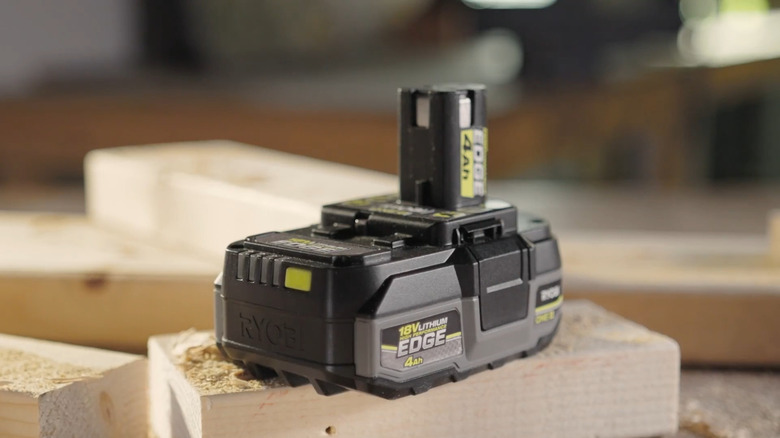Ryobi 18V Edge Vs. 18V HP Batteries: What's The Difference?
Ryobi's 18V system is the biggest of its product lines and arguably its most popular. Unlike the 40V, 80V, and USB Lithium battery systems with only under 100 tools, the 18V series features more than 300. The selection ranges from Ryobi cleaning equipment like carpet washers and pool vacuums to power tools like impact wrenches and circular saws.
What makes the 18V portfolio even more versatile is its multiple battery tiers. You don't get plenty of options when it comes to the other Ryobi battery systems, but for the 18V, you can pick from one of three tiers: the basic ONE+ battery, ONE+ HP, and ONE+ HP Edge.
The last two tiers are considered superior over the basic ONE+, making both of them best for more demanding tasks. But how exactly are they different? Well, for one, the Ryobi 18V HP Edge batteries are slightly pricier than their 18V HP counterparts. Besides the bigger price tag, they pack in better performance for your tools too.
The advantages of Ryobi's 18V HP Edge battery over the 18V HP version
The biggest differences between the Ryobi 18V HP Edge and the 18V HP batteries are power and runtime. Compared to the HP, the Edge can supply up to twice as much power to the tool and make it last four times longer.
This significant upgrade is all thanks to the innovations integrated into the 18V Edge battery. Just like the 18V HP and other ONE+ batteries, the Edge battery is powered by a Ryobi battery technology called IntelliCell. It works as a self-monitoring system that maintains an even power demand distribution among all the cells in the battery pack. This, in turn, extends the battery runtime and lifespan and delivers a more stable power.
On top of this technology, though, the Ryobi 18V HP Edge battery comes with two more features you won't find on all the 18V HP batteries: tabless cells and Cool-Core Pro. Tabless cells are more efficient in terms of energy transfer, so your tool can get the most out of the battery pack. Cool-Core Pro, on the other hand, is a heat management solution similar to the HP battery's Cool-Core. But instead of just focusing on the design of the cell and pack, Cool-Core Pro also integrates better heat sinks and cell straps to further improve the operating temperature.
Although it looks like the 18V Edge is an overall better choice, there's one drawback it has — limited capacity options. It only comes in one capacity, a 4Ah, unlike the 18V HP that has a 2Ah, 4Ah, 6Ah, 8Ah, and 12Ah selection. This is probably because it was just released in 2024.
How the batteries compare in real-world tests
As tested by Ryobi itself, the 18V 4Ah Edge battery outperforms the 18V 4Ah HP, and even the 18V 8Ah HP batteries in several applications. In cutting double-stacked 3/4" OSBs with a 6-1/2" circular saw, the Edge finished one to two seconds ahead of the 8Ah HP and four to five seconds ahead of the 4Ah. It showed slightly less time difference when cutting a 10" log with a 12" chainsaw, or drilling three holes through 2 by 6" white pine with a 1/2" hammer drill.
YouTuber Man Meets Money ran a wood-cutting comparison test between the 4Ah Edge and 4Ah HP too. In the test, the Edge cuts the board faster without getting bogged down unlike the HP. In another performance test by YouTuber ToolSpecs, removing wheel nuts with an impact wrench paired with a 4Ah HP, 6Ah HP, and 4Ah Edge battery, it took the 4Ah HP between seven and fifteen seconds, the 6Ah HP six to eight seconds, and the 4Ah Edge just four to five seconds to unscrew the nuts.
Runtime-wise, the 18V Edge also lives up to its claims. Compared to the 18V 4Ah HP, the 18V 4Ah Edge provides 25% more runtime to a 5" Random Orbit Sander, and 66% more runtime to a Brushless Four-Mode 1/2" High Torque Impact Wrench.
According to a charge time test done by YouTuber Tool Review Zone, the 18V 4Ah Edge apparently charges a lot faster than its HP counterpart as well. Charging the Ryobi battery to full charge, the Edge only needs 36 minutes in the Ryobi 8A Rapid Charger, while the HP takes close to 41 minutes.


